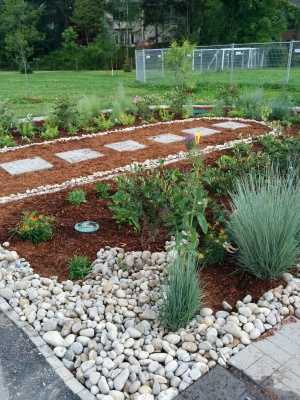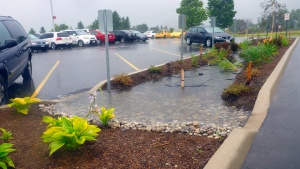Difference between revisions of "Stone"
Jump to navigation
Jump to search
Kyle menken (talk | contribs) m |
Kyle menken (talk | contribs) m |
||
| Line 2: | Line 2: | ||
[[File: IMAX_Stone_Inlet.jpeg|thumb|This bioswale in a parking lot uses stone at the inlets and along the bottom of the swale to prevent erosion, as the sides are sloped.]] | [[File: IMAX_Stone_Inlet.jpeg|thumb|This bioswale in a parking lot uses stone at the inlets and along the bottom of the swale to prevent erosion, as the sides are sloped.]] | ||
For advice on aggregates used in [[Underdrains]], see [[Gravel]] | For advice on aggregates used in [[Underdrains|underdrains]], see [[Gravel|gravel]] | ||
Stone can serve as a low maintenance decorative feature, but it may also serve practical functions in an LID practice. | Stone can serve as a low maintenance decorative feature, but it may also serve practical functions in an LID practice. | ||
Revision as of 20:17, 9 January 2018
For advice on aggregates used in underdrains, see gravel
Stone can serve as a low maintenance decorative feature, but it may also serve practical functions in an LID practice. Typical stone functions in LID and direction on selection:
Dissipate flow and prevent erosion at inlets and outlets
- Angular crushed stone, which will "knit" or lock together and be less likely to shift, is recommended. However, for aesthetic purposes, smooth river-run stone may be desired.
- Determine stone size by flow velocities at inlets and outlets. Typical stone for this purpose ranges between 50 mm and 250 mm. The larger the stone, the more energy dissipation.
- Stone beds should be twice as thick as the largest stone's diameter.
- To prevent erosion of soils beneath the stone and the migration of the stone into the soil, the stone bed should be underlain by a drainage geotextile.
Direct and spread flow throughout a large LID facility or to protect narrow channel sections where flow will concentrate
- While crushed stone will be less likely to shift, river-run stone may be used to create a dry-stream-bed look.
- The sizing of the gravel will depend on the expected velocities.

